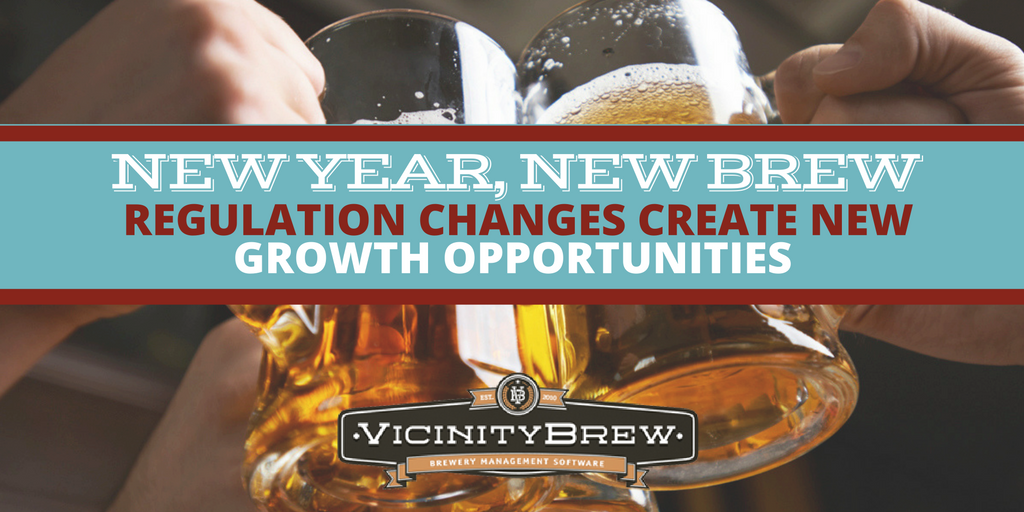In 2017, changes to regulations for the brewing industry’s production and distribution, are creating new beer growth opportunities for craft breweries in several states.

New Production Beer Growth Opportunities in 2017
Tennessee
“As of January 1st, breweries throughout Tennessee can now serve beers up to 10.1 percent alcohol by volume, or 8 percent by weight, without seeking a license through the Alcoholic Beverage Commission,” reported Raishad Hardnett, WBIR. “The old alcohol by volume limit was 6.3 percent, or 5 percent by weight.
What This Means for Your Brewery: If you are a Tennessee brewery, like Fat Bottom, this means that you will now be able to create a wider variety of brews outside of the previous ABV limitations. Now that Tennessee breweries will be able to create brews with a higher alcohol volume, it is important to have a solid foundation as you review how to take on an expanded product mix.
Colorado
KOAA News reported that Coloradoans will see the most drastic change to liquor laws since prohibition with a full-strength beer phase-in.
Lena Howland states, “Governor Hickenlooper voted earlier this year that, come January, grocery stores will be able to have up to five locations with beer, wine and liquor.
They’ll also be repealing the state’s 3.2 beer law within the next two years, which means stronger beer available to you at the same place you buy your groceries.”
In 2016, the brewing industry monitored the new Marijuana laws quite closely to see if and how they would impact the brewing industry. Breweries in Colorado can find some relief in the fact that “medical marijuana caregivers will be facing tougher rules when it comes to the number of plants they can grow at home. According to state law, that number is dropping from 495 to 99 plants,” said Lena Howland.
What This Means for Your Brewery: The changes in regulation directly impact the retail customer landscape for CO craft brewers. Similar to Tennessee’s updated beer laws, the new law for Colorado regarding ABV will impact the different types of beer sold. Grocery accounts can now diversify their craft beer selection available, increasing the variety of SKU’s craft brewers can supply to existing grocery customers. In addition, an increased amount of grocery stores carrying beer could mean an increased reach and opportunity for sales growth for brands in the craft beer space.
How VicinityBrew Software Can Help: VicinityBrew Brewery Management Software can help support the expansion of a brewery’s product mix by connecting departments and implementing tighter controls on your supply chain management. Delivering an end to end solution from sales, to production and distribution by delivering an end to end solution from sales orders to distribution and streamlining production. Effectively manage your distribution channel given the introduction of new brews or an influx of orders in a particular style, while controlling your production processes, use software to efficiently plan, schedule and coordinate all production activities.
New Distribution Beer Growth Opportunities in 2017
Pennsylvania
According to Lancaster Online, beginning Jan. 14, beer distributors will be able to sell beer in any quantity, including 32-ounce bottles, four-packs, six-packs and growlers.
Beer distributors had long sought to loosen restrictions on the beer quantities they could sell which had limited them to selling cases, 12-packs and kegs.
What This Means for Your Brewery: Now that beer distributors can sell a more extensive variety of brew packaging types, craft breweries in Pennsylvania, like Victory Beer, can justify packaging brews in larger bottles, four-packs, six-packs, and growlers in addition to cases, 12-packs and kegs. This growth opportunity can attract an more diverse customer base.
How VicinityBrew Software Can Help: VicinityBrew can help manage your brewery’s production by allowing you to plan production by recipe instead of just planning by finished good or individual BOM. When a scheduler has visibility into overall finished good demands with the ability to filter these demand views by the common recipe being used, the scheduler is able to create larger batches by combining demand for multiple container sizes. Simplifying the process to mirror the natural tendency to schedule by brite tank.
Contact us today for more information on how VicinityBrew Software can help your beer growth in 2017!
